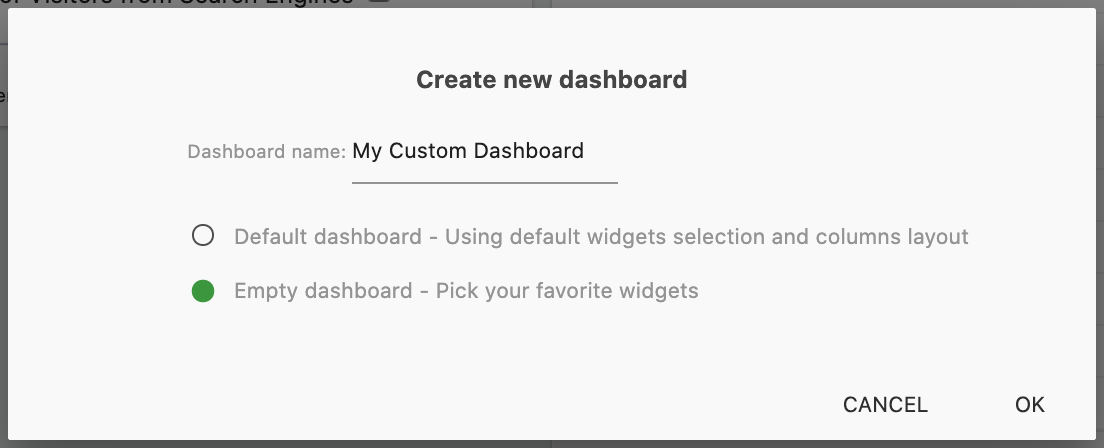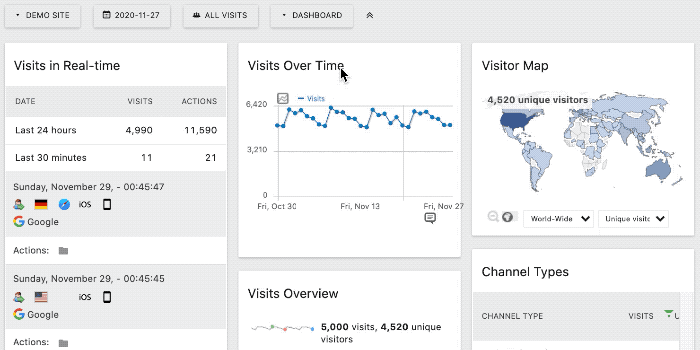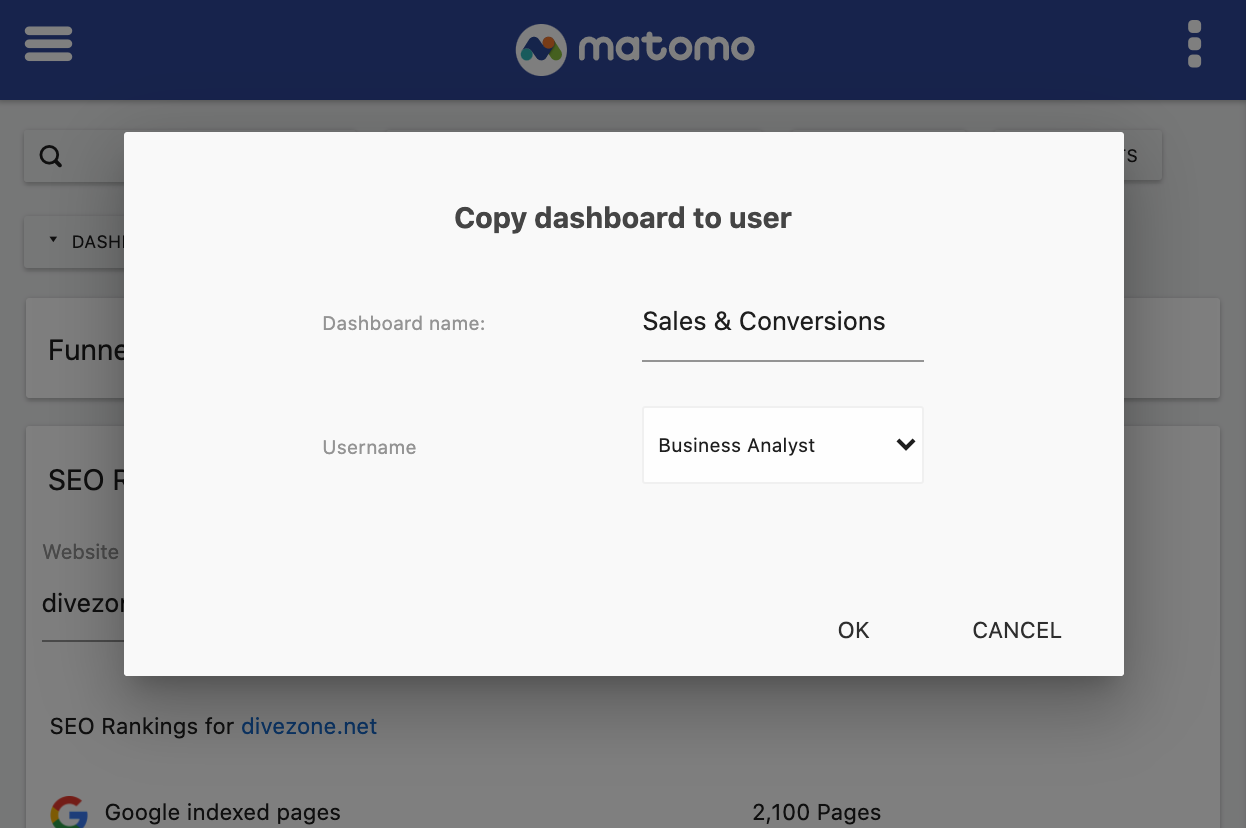Create Dashboards and customise Widgets and Layout
You can create and customise as many dashboards as you need. Within each dashboard, it is possible to curate your own selection of widgets and arrange them into different layouts. The majority of these settings are available through the dashboard menu. You can access this menu by clicking the Dashboard button in the Data Selector area.

How to create a new Dashboard
Whenever there is a unique collection of reports you need to check regularly, it is worth considering creating a dashboard. There might be some reports you check daily, while others are only useful monthly or for particular projects. In any case, you can create task-oriented dashboards containing elements from multiple sections of your analytics data.
The steps for creating a new dashboard are as follows:
-
Go to the Dashboard section in the main navigation.
-
Click the Dashboard button.

-
Click Create new dashboard to bring up the dashboard creation popup.

-
Type a descriptive name in the field that pops up.
-
Choose between an Empty dashboard (recommended) or the default dashboard.
-
Click OK and then Add A Widget to load the widget selection menu and get started.
How to add Widgets to your Dashboard
When in the Dashboard section, click on the Dashboard button in the data selector area to bring up the Dashboard menu. At the top of this menu, you will see a section to Add a widget. This menu area lists all of the available widgets you can add to your dashboard.

All authenticated users can add widgets to their personal dashboards in Matomo. These widgets are saved to the user’s account, so the dashboard layout and selections remain available across sessions and devices.
For Matomo On-Premise, anonymous users can also add widgets to a dashboard. However, if the browser cookies are cleared or the session expires, all added widgets are lost. Anonymous dashboards are therefore only suitable for temporary use.
You can add as many, or as few, widgets as you need. Generally, you should aim to add your most frequented statistics so you can keep track of them at a glance after logging in.
Dashboard-specific Widgets
While many widgets offer reports that are available within other reporting sections of Matomo, there are some widgets which are only available within customised dashboards. Below you will find a few examples of these widgets.
How to manage existing Widgets
To manage existing widgets within your dashboard: hover your mouse above the top right of the widget card to bring up the Widget Menu.

In this menu, you will see four icons. From left to right, these are:
- Refresh
 – This updates the widget data with any changes since it was loaded. This can be especially helpful when testing and analysing with real-time activity on the website.
– This updates the widget data with any changes since it was loaded. This can be especially helpful when testing and analysing with real-time activity on the website. - Minimise
 – This temporarily hides the data in the widget, which can be helpful if you have lots of widgets on a page, or certain data that does not need to be checked frequently.
– This temporarily hides the data in the widget, which can be helpful if you have lots of widgets on a page, or certain data that does not need to be checked frequently. - Maximise
 – There are two potential actions when clicking on this icon. If the widget is currently minimised so you cannot see any data, then it will return to its normal size. If the widget is already at normal size, then clicking this icon loads a popup containing a larger version of the data. Maximised widgets can make data within certain graphs easier to read.
– There are two potential actions when clicking on this icon. If the widget is currently minimised so you cannot see any data, then it will return to its normal size. If the widget is already at normal size, then clicking this icon loads a popup containing a larger version of the data. Maximised widgets can make data within certain graphs easier to read. - Close
 – This completely deletes the widget from your dashboard. You should only use it if you are not interested in seeing that widget on the dashboard again. If you want to see it later, you will need to re-add the widget to your dashboard.
– This completely deletes the widget from your dashboard. You should only use it if you are not interested in seeing that widget on the dashboard again. If you want to see it later, you will need to re-add the widget to your dashboard.
How to customise your Dashboard Layout
When you first add new widgets to your dashboard, they might not be in the most logical order. Additionally, some widgets inherently work better at a smaller or larger size. This is where customising the layout of your dashboard comes into play.
Change the number of columns on your Dashboard
While on your dashboard page, click the Dashboard button. This will bring up the dashboard menu where you will see a Manage dashboard section at the bottom. Within this section, there is a change dashboard layout button which allows you to alter the number and width of columns on the page. You can have anywhere between one and four columns of varying widths. It is generally easier to choose a layout after you have selected your dashboards widgets, so you know how much space you need for each.

How to reorder and move Widgets within your Dashboard
After you have selected a layout, you can simply move things around with your mouse via drag and drop. Simply hover your mouse over the top part of the widget until the crosshair icon ![]() appears as shown below. Then click and hold your mouse whilst moving the widget into the desired position.
appears as shown below. Then click and hold your mouse whilst moving the widget into the desired position.

Removing, renaming and resetting a Dashboard
Also within the Manage dashboard section of the Dashboard menu, you will find several options for the dashboard you are working with. The settings are all fairly self-explanatory.
- You can click remove dashboard to get rid of the current dashboard you are viewing. It is not possible to delete the default dashboard, but you can remove any other dashboards you no longer need.
- There is a reset dashboard link which removes all widgets from the current dashboard and replaces them with the default configuration so you can start again.
- You can also use the rename dashboard link to customise the label shown in the Main Navigation. Setting descriptive names for your dashboards makes it easier to navigate between them.
If you are a superuser, then you will also see the set as the default widgets selection link which allows you to curate the default selection of widgets for any new websites or users of your Matomo instance.
Share your custom Dashboards with other users
If you work on a team with several people accessing your analytics, it is possible to create and then share custom dashboards with other users. This means you can share useful dashboards amongst your team for a central reference point. Or you can share your key performance indicators with members of your wider organisation. Instructions on how to share your dashboards can be found here. This feature is only available to accounts with Superuser permissions.

Learn more about Sharing dashboards with others